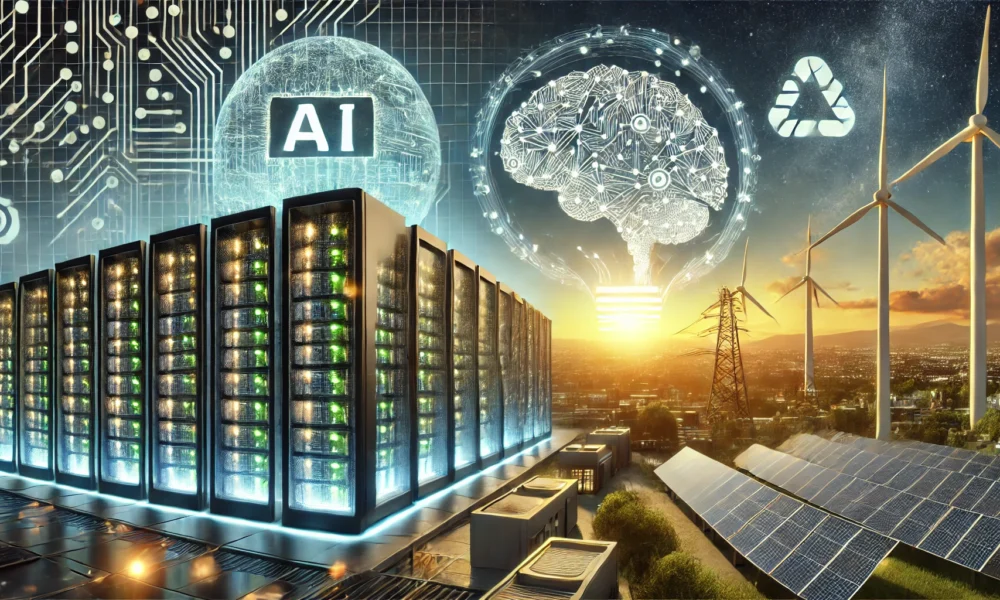Revolutionizing the Energy Sector: How Artificial Intelligence is Shaping the Future
Artificial intelligence (AI) is not only revolutionizing technology but also making a significant impact on the global energy sector. The latest report from the International Energy Agency (IEA) highlights how AI’s rapid growth, especially in data centers, is driving an increase in electricity demand. Despite this, AI presents opportunities for the energy industry to enhance efficiency, sustainability, and resilience, ultimately transforming the way we generate, consume, and manage electricity.
The Impact of AI on Global Electricity Demands
AI is significantly driving the growth of data centers, which are crucial for running AI models. As AI technologies become more advanced and widespread, the demand for computing power and the energy to support it is expected to rise. The IEA report projects that data center electricity consumption will double by 2030, surpassing 945 TWh. This surge is driven by the increasing demand for high-performance computing in AI models, particularly those utilizing accelerated servers.
Data centers currently consume 1.5% of global electricity, but this share is expected to grow in the coming years due to the energy-intensive nature of AI. Specialized hardware like GPUs and accelerated servers are key to this growth, shaping the future of electricity consumption.
Regional Variances in AI’s Energy Impact
The electricity consumption from data centers is not evenly spread worldwide, with the United States, China, and Europe leading the demand. In the U.S., data centers are forecasted to make up almost half of the nation’s electricity demand growth by 2030. In contrast, emerging economies like Southeast Asia and India are seeing rapid data center development, although their demand growth is less compared to developed nations.
This concentration of data centers poses challenges for electricity grids, particularly in regions with strained infrastructure. The high energy demands from these centers can lead to grid congestion and connection delays, highlighting the need for proper planning to address these issues.
Strategies to Address AI’s Growing Energy Needs
The IEA report proposes various strategies to meet the increasing electricity demands of AI while ensuring grid reliability. Diversifying energy sources is key, with renewables playing a central role in meeting data center demand growth. Other sources like natural gas, nuclear power, and emerging technologies such as small modular reactors will also contribute to meeting energy needs.
Renewables are projected to supply nearly half of the global data center demand growth by 2035, supported by energy storage solutions and flexible grid management to balance the intermittent nature of renewable energy. AI itself can optimize energy efficiency, improving power plant operations and grid management.
Enhancing the Energy Sector with AI
AI serves as a valuable tool for optimizing energy systems by enhancing production, reducing costs, and integrating renewable energy into existing grids. By leveraging AI for real-time monitoring, predictive maintenance, and grid optimization, energy companies can increase efficiency and decrease emissions. The IEA estimates potential annual savings of $110 billion in the electricity sector by 2035 through widespread AI adoption.
- Forecasting Supply and Demand: AI aids in predicting renewable energy availability, essential for integrating variable sources into the grid.
- Predictive Maintenance: AI monitors energy infrastructure to predict faults and prevent outages.
- Grid Management: AI optimizes power flow from sensors and smart meters, ensuring stable grid operations.
- Demand Response: AI enables better electricity price forecasting and dynamic pricing models.
- Consumer Services: AI enhances customer experience through apps and chatbots, improving energy management.
AI also reduces energy consumption by enhancing the efficiency of energy-intensive processes, playing a crucial role in balancing supply and demand as the energy sector becomes more digitized.
Challenges and the Path Forward
While the integration of AI into the energy sector shows promise, uncertainties remain regarding the speed of AI adoption, advancements in AI hardware efficiency, and meeting increasing energy demands. Collaborative efforts between the energy and technology sectors, along with strategic policy planning, are vital to harnessing AI’s potential in the energy industry.
The Future of AI in the Energy Sector
AI is transforming the global electricity sector, presenting challenges and opportunities for the industry to evolve and improve efficiency sustainably. By leveraging AI to diversify energy sources and optimize energy systems, we can meet the growing power needs of AI while driving major changes in electricity generation, distribution, and consumption over the next decade.
-
What role does artificial intelligence play in shaping the future of electricity distribution?
Answer: Artificial intelligence is being used to optimize electricity grids, predict consumer demand, and increase the efficiency of renewable energy sources, leading to a more sustainable and reliable electricity distribution system. -
How is AI helping to address the challenges of integrating renewable energy sources into the grid?
Answer: AI is being used to manage the variability of renewable energy sources like solar and wind power, through accurate forecasting and real-time adjustments to ensure a stable and reliable electricity supply. -
What are some of the benefits of using AI in electricity distribution systems?
Answer: Some benefits of using AI in electricity distribution systems include reduced costs, increased reliability, improved efficiency, and better integration of renewable energy sources into the grid. -
How is AI helping utilities and grid operators to detect and respond to electricity grid disruptions more quickly?
Answer: AI is being used to analyze large amounts of data from sensors and meters in real-time, allowing utilities to detect and respond to grid disruptions faster and more accurately, reducing downtime and improving customer satisfaction. - How can policymakers and industry stakeholders leverage AI to accelerate the transition to a more sustainable and efficient electricity system?
Answer: By investing in AI technologies and supporting innovation in the electricity sector, policymakers and industry stakeholders can accelerate the transition to a more sustainable and efficient electricity system, ultimately reducing carbon emissions and increasing energy security.

